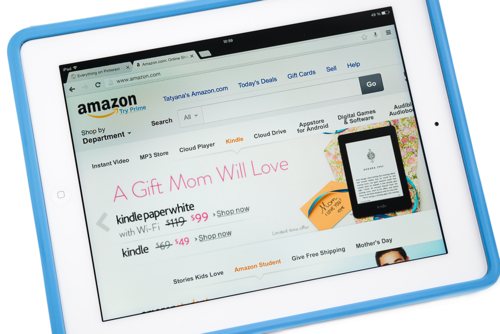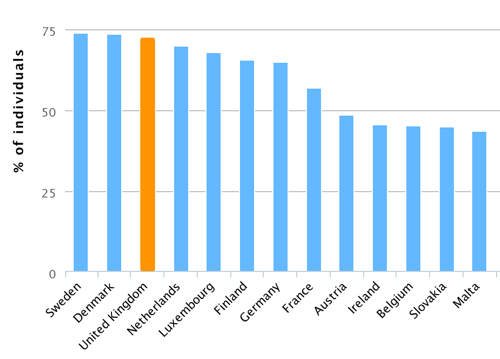Blog posts tagged ecommerce
On Cyber Monday, what’s your biggest website fear?
 The run-up to Christmas is a key time for online retailers. In fact, today is the much-hyped Cyber Monday, often cited as the biggest day of the year for online shopping.
The run-up to Christmas is a key time for online retailers. In fact, today is the much-hyped Cyber Monday, often cited as the biggest day of the year for online shopping.
(You might recall that Amazon stole the show on Cyber Monday last year by announcing deliveries by drone.)
The next couple of weeks really matter
If you run an online retailer, there’s a good chance your annual performance hinges on the next couple of weeks.
It's important to capture as much consumer spending now, before 2015 starts and people’s wallets go back in their pockets.
Although the logistics of fulfilling orders can pose a headache, a Barclays survey reveals the main fear of 51% of retailers is the possibility of their website going down.
That fear is grounded in logic. If your online sales total £2,000 a day — and assuming those purchases mostly happen between 9am – 10pm — an hour’s downtime could easily cost you £100 - £150 in lost sales.
A major outage could be disastrous at this time of year, forcing customers to look elsewhere and potentially hitting your reputation and repeat business.
Plan all year round
“The stakes are high during the holiday season, and retailers cannot afford to have their sites crash and burn,” confirms Paul Heywood, EMEA director at internet performance experts Dyn.
He says the best way to prepare your website for Christmas is to aim for optimum performance the whole year round:
“Providing a reliable online experience should be part of a long term, proactive approach.”
“Retailers are faced with the year-round challenge of fickle customer loyalty — if your website experience doesn't match their expectations or is too slow your customers will quickly turn to a rival brand.”
What you can do now
He's right, of course. Website uptime matters all the time. But it matters even more at this time of year. So to help your site remain available, it’s worth following these four tips:
- Avoid big changes. When M&S changed its website earlier this year, sales dropped by 8%. When you make sweeping changes to a site, it's common for conversion rates to drop temporarily while customers adjust. So if you're planning to launch a redesigned website, hold off until 2015.
- Check your hosting and domain names. You don’t want your site to be suspended because your domain expires or you hit your traffic limits. Make sure everything is ok for the rest of December.
- Know who to call. If something does go wrong, you won’t want to waste time scrambling to find contact details. Put together a file containing this information and make sure everyone knows where it is.
- Arrange out-of-hours cover. Online shopping happens 24/7, so make sure someone monitors your site out of hours. And yes, that includes over Christmas, because Boxing Day is one of the biggest shopping days of the year.
Finally, if you don’t already have it, set up website monitoring. Various services will send you emails or text messages to alert you to problems. After all, you can’t fix an issue unless you know about it.
M&S shows the dangers of redesigning your website
 |
| Copyright: Tupungato |
Marks & Spencer’s new website — which launched in February — reportedly cost an enormous £150m. No, we’re not quite sure how on earth it’s possible to spend that much on a website, either.
Yet despite this huge investment, things haven’t gone quite to plan.
The company’s online sales dropped 8% in the 13 weeks previous to 28 June, despite this shiny new site that was — presumably — intended to make it easier for consumers to part with their cash. Oops.
High stakes website redesign
It’s tempting to chuckle at the online misfortunes of a big retailer like this. But in truth, launching a new website is a high-stakes game for anyone.
No matter whether your online business is a one-person micro-company or a 130-year-old icon like M&S, you never quite know what’s going to happen when you flick the ‘on’ switch.
For starters, some current customers will almost certainly be confused by and resistant to the change.
Even if your old website was a nightmare to navigate, your most loyal visitors will have got used to it. When you redesign it, you force them to learn a new way of doing things.
Every website redesign faces this problem, but M&S appears to have compounded things by forcing existing customers to re-register on the new site.
Yes, even if you’ve made regular online purchases in the past, you’re apparently forced to re-enter your details before you can buy online. As anyone with any experience of selling online will know, that’s bound to affect conversion rates.
We can only assume that some kind of serious technical issues prevented M&S keeping the old user database, because it’s hard to understand why any retailer would choose to start from scratch again in this way.
Does M&S face fundamental issues?
More worryingly, some industry commentators think the site faces fundamental issues. According to this Marketing Week piece, retail analyst Neil Saunders reckons the new M&S.com has forgotten some of the basics:
“…it falls down in the more critical function of making it easy for customers to purchase. Indeed, there are some parts of the site where it is extremely difficult for customers to understand the path they need to take to buy product.”
It’s far too early to tell whether the M&S website will be a long-term success. But if you’re planning to re-launch your ecommerce website, here are three ways to avoid similar problems:
- Stay focused on conversion. Your website is useless if it doesn’t sell. When considering design approaches and evaluating features, ask one simple question: ‘will this improve our conversion rate?’
If not, or you’re not sure, steer clear. It’s easy to get distracted by bells and whistles during the exciting process of creating a new site. Yet visitors want a simple site so they can buy what they want, fast.
- Show customers your website early. Share wireframes, prototypes and designs with current and potential customers to see what they think.
On bigger website projects, it can be helpful to build a basic prototype, to see how people fare when they use it. Is it easy to find your products? Can customers figure out how to check out?
- Consider a limited release. If you run an online company, your website pretty much is your business. When you launch your new site, see if you can find a way to run it in parallel with the old for a while.
For instance, you might use A/B testing tools to show 20% of visitors your new site, while the other 80% see the old one. Once you’re confident the new site is performing, you can roll it to 100% of visitors.
Have you launched a new online shop recently? How’s it performing? Leave a comment to let us know.
How marketplaces like Amazon can help you sell online

Image copyright: Dr. Cloud
New research from terribly-spelt online marketplace provider Mirakl suggests that online shoppers are still most attracted by the prospect of a bargain when choosing where to buy.
The survey asked 1,000 UK consumers to identify factors that influence where they buy from online. Almost half (49%) of respondents said that price was important.
Consumers also look for retailers they trust (23%) and value good customer service.
However, the ability to order online and collect instore was much less of a factor. Only 3% said this was important to them, while just 2% said that having a good mobile-optimised website was the main reason to buy somewhere.
There's good and bad news here for smaller businesses. If your competitors include online giants like Amazon, competing on price is always going to be difficult.
However, with brand recognition and trust also important, it may be possible to turn the might of online marketplaces like Amazon to your own advantage.
Quite simply, you can often reach a wider audience by selling your products through these sites as well as — or instead of — running your own online shop.
If you sell online, it's certainly worth investigating. If you can't beat 'em, why not join 'em?
Get advice about selling through marketplaces from Marketing Donut.
Five quick ways to boost your website's conversion rate
 If you run an online shop, sometimes it can feel like you’re always trying to find the next big sales boost. What can you do to get more people buying from you on the web?
If you run an online shop, sometimes it can feel like you’re always trying to find the next big sales boost. What can you do to get more people buying from you on the web?
But when you’re throwing big ideas around, it’s easy to overlook the quick wins. Here are five things you can do in the short term to improve your conversion rate and boost your bottom line.
1. Stop relying on guesswork
When businesses are seeking to improve their conversion rate, the biggest mistake they make is to assume they know what will work.
You probably have access to lots of information that’ll help you determine what to change on your website. Use Google Analytics to try and identify where people are dropping out of your purchasing process. Are conversion rates markedly lower for people using mobile devices?
Use these insights to plan some simple tests. Run these past colleagues or trusted customers to see what they think, before you go to the trouble of implementing them.
2. Get feedback from your users
You might assume that it’s difficult to get people on your website to tell you what they think of it. But actually, it can be quite easy.
Tools like Qualaroo Insights, SurveyMonkey and Zoomerang let you ask users specific questions, giving you feedback straight from the people that matter most.
(You will, of course, get useless and sometimes abusive responses. That’s the internet for you, so be prepared to take the rough with the smooth.)
3. Build credibility and trust
Studies show human behaviour is advancing and the conversion funnel is getting longer, which means users are taking time to understand how much they can trust your business before they part with their cash.
There are lots of ways to appear more trustworthy on the internet. One of the easiest options is to show some online reviews of your company on your website.
You can also check key competitor websites to see what they do to boost credibility.
4. Write your call to action
The actions and psychological triggers that customers are exposed to can drastically affect conversion rates. So why not try testing some new call to action text? Here are some ideas:
- Inject some urgency by labelling buttons ‘Buy now’ instead of ‘Add to cart’.
- Incorporate hard facts and supporting information, like ‘90% of people prefer our product’.
- Make sure you’re reinforcing your strongest unique selling point when you want users to take that action.
5. Get rid of unnecessary steps
Long checkout or signup forms are unnecessary. Make sure there’s a concrete reason you’re asking for each piece of information.
For instance, do you really need the customer’s phone number or date of birth? Reducing the length of a form can significantly increase the proportion of people who complete it.
Also make sure your account signup process happens after the customer has completed their purchase. After all, getting the money in the bank is more valuable than the registration details.
- Turn visitors into buyers with web analytics
- The cost of poor website performance
- How to track your website visitors
This is a post from Chris Turton, managing director of conversion strategy firm ClearVolume.
Product intelligence: the future of ecommerce?
 When you’re selling online, how quickly you’re able to deliver your products can make or break your business. If your next-day delivery promise turns out to be hogwash then you’ll see customers switching to more reliable competitors.
When you’re selling online, how quickly you’re able to deliver your products can make or break your business. If your next-day delivery promise turns out to be hogwash then you’ll see customers switching to more reliable competitors.
The University of Cambridge, working together with James and James Fulfilment, is carrying out research that it thinks could lead to a new means of online order delivery — allowing consumers to interact with their order almost right up until it arrives.
Ecommerce product intelligence
The research is based on the concept of ‘product intelligence’, where computer models allow every product and order in a warehouse to effectively think for itself.
What does that mean? Well, if the researchers are correct, orders themselves will soon be able to communicate with warehouse and delivery staff to make sure that they are processed correctly.
Product intelligence could let consumers interact with their order right up until it is delivered.
For instance, currently if a customer wants to change the delivery address once an order has been dispatched, they have to contact the courier. But with product intelligence, they could let the order know the new address — electronically.
Popping out? Let your order know
In fact, it could be possible for consumers to interact directly with their online orders at every stage of the journey.
You might be able to tell your order that you’re are not at home because you’ve popped to a café down the road. Or you could even say: ‘use my mobile phone to come and find me’ while your parcel is out for delivery. Imagine that: no more ‘we called while you were out’ cards.
The difference with product intelligence is that the order will tell the carrier what it needs to do, rather than the customer telling the carrier. It sounds futuristic, but the infrastructure is mostly already in place, so the technology could become available very soon.
Product intelligence and efficiency
Product intelligence could also allow goods to decide where in a warehouse they should be stored. The researchers have found that doing this can be 20% more efficient than current best practice.
Although it might seem obvious that the fastest-selling products should be kept closest to the packing station, actually getting the information required to arrange products correctly is not easy.
When the products can confer amongst themselves, products that are frequently shipped together will know they should be stored together.
While online ordering has vastly improved in the past decade to become a slick, real-time process, many fulfilment centres and carriers have failed to invest at the same rate.
That’s why product intelligence has such huge potential: it could save businesses considerable time and money, and deliver much higher levels of customer satisfaction.
- Are small companies lagging behind in ecommerce?
- How to convert reluctant customers online
- Set up ecommerce on a budget
This is a guest post from James and James Fulfilment.
If your customers don’t know what SSL is, do you need it?
![]() The average internet shopper doesn’t have a clue what an SSL certificate. Come to think of it, do you know what an SSL certificate is?
The average internet shopper doesn’t have a clue what an SSL certificate. Come to think of it, do you know what an SSL certificate is?
If not, here’s a brief explanation: an SSL certificate allows your website to display the secure padlock when people visit it. It also encrypts data transferred between your website and its visitors (like their credit card details), so it can’t be accessed by online criminals.
If you sell online, it is important to have an SSL certificate — and not just because it protects your customer’s card details. Here’s why:
1. Your customers do care about security
Just because your customers don’t know what an SSL certificate is doesn’t mean they don’t want reassurance when they’re shopping online.
Many factors help determine whether online shoppers feel safe enough to make a purchase from you, and you don’t control all of them. For instance, you can’t invent a trusted brand that’s been around for a hundred years.
However, you can make your customers feel more at ease by displaying an SSL certificate. One study found 94% of consumers were more likely to proceed with an online purchase when they saw the Norton Secured Seal during checkout.
2. It’s a legal requirement
Every website owner has a responsibility to make sure the data their website collects or uses is kept safe.
This responsibility may be a legal obligation, depending on what type of data you collect or use. If you process credit card details, for example, it’s essential that this data is securely encrypted.
3. Your reputation could be at risk
Barely a week goes by without news of data being stolen or hacked. Just one such incident can damage your company’s reputation.
Don’t think this will ever happen to your business? The numbers don’t look great: according to government figures, 76% of small companies suffered a security breach in 2012. What’s more, experts have warned that smaller companies are increasingly being targeted by online criminals.
- SSL encryption for your website explained
- Hackers: they’re everywhere, every day
- Protect your business from a cyber attack
This post was written by John Philips from SSLs.com, a reseller of SSL certificates.
How to handle Cyber Monday

In what can only be a carefully-timed PR move, Amazon has this morning secured impressive coverage by announcing that it's testing the use of drones for deliveries.
Why so carefully-timed? Well, today just so happens to be Cyber Monday, the day when online sales peak in the run-up to Christmas. Experts are predicting that internet spending today could hit £500m, making it the biggest online shopping day in history.
Self-fulfilling?
Never mind that drone deliveries are likely still years off — what matters to Amazon is that it has got its brand into the BBC website's top 'most read' slot on the busiest digital retail day of the year.
While it's true that Cyber Monday has become something of a self-fulfilling prophecy, there is no doubt that the first Monday in December is a key online shopping day. So, if you sell online, it could pay to be prepared.
Last-minute Cyber Monday preparations
Ok, so without the PR budget of Amazon you're unlikely to secure similar levels of brand coverage. However, if you sell online, there are still things you can do to make sure you handle Cyber Monday well.
It's a little late now to do anything more than last-minute preparations, of course. But you can certainly make sure that your website's working properly and you're ready to handle orders that arrive:
- Check your website is functioning ok. At any time of year, website downtime means lost revenue. But on the busiest day of the year, the impact will obviously be higher. Have you checked it today yet? Go on, do a test order right now.
- Postpone non-essential maintenance. There is absolutely no point in doing anything that could hit your website sales on the busiest day of the year. Updating your website's software? Just wait till tomorrow.
- Consider upping your online advertising. It depends on your budget and your market, of course. But in general, more consumers will be online today hunting for gifts. You could reach more of them by increasing your online advertising spend.
- Be ready to pack and ship orders. One of the most effective ways to keep your customers happy is to pack and send orders quickly. Now's the time to nip out for bubblewrap and sticky tape, if you're running low.
- Think about staying late. Retailers including Amazon and John Lewis expect sales to peak this evening, from 6pm — 9pm. It might be worth hanging on in the office, just to make sure your website keeps running smoothly.
How have you found Cyber Monday in previous years? Does it deliver a boost to your bottom line, or is it nothing more than a load of hype?
Are small companies lagging behind in ecommerce?
The UK has embraced ecommerce more enthusiastically than every other EU country bar Sweden and Denmark.
Buying stuff online is incredibly popular, with more than 73% of people buying at least something online in 2012. The EU average was just below 50%, so where online shopping is concerned the UK really does blaze a trail.
Check out this graph from the EU's Digital Agenda. Each bar represents the percentage of individuals who bought online in 2012. The highlighted bar shows where the UK sits in the EU's top nations:

As you'd expect, this has resulted in a seriously big internet shopping market. E-retail expert IMRG reckons it's worth around £78bn.
Yet when you dig deeper into how that market is made up, it looks like smaller companies aren't claiming their fair share of the territory.
Enterprises surge ahead
According to EU figures for 2012, just 17% of UK small and medium-sized enterprises (SMEs) sell their goods or services online. Take in isolation, that sounds pretty low. But when you realise 42% of enterprises sell online, you can see the gap is actually pretty large.
As if to underline this discrepancy, the same research suggests that while online sales account for 25% of total enterprise turnover, for SMEs the figure is a paltry 8%.
Ecommerce is getting easier
|
It's not difficult to draw a conclusion here. It seems larger companies have managed to incorporate online selling into their business models more effectively than smaller competitors.
Setting up an online shop used to be really tricky. You had to build the whole thing from scratch, creating your online catalogue, shopping basket system and payment services from nothing.
That required real expertise - and the kind of money only bigger companies have.
But things are very different a few years on. You don't need much technical knowledge at all to sell online.
Reclaiming lost ground?
You can use an off-the-shelf ecommerce system to provide the framework for your shop. All you have to do is to populate it with your products and work out how to deliver them.
So, as it's so easy to start selling online, can we expect a surge in smaller companies doing so? Perhaps they're about to reclaim some of that lost ground.
Or, more depressingly, is the best model for online commerce to pile 'em high and sell 'em cheap? If so, smaller companies must find their niche to sell online effectively. Because it's almost impossible to take on giants like Amazon and beat them at their own game.
How does selling online work for your business?
Hackers: they're everywhere, every day
 Hackers. They attack someone, somewhere, every day. They are omnipresent on the internet. Their main targets include governments, TV channels, banks and big companies.
Hackers. They attack someone, somewhere, every day. They are omnipresent on the internet. Their main targets include governments, TV channels, banks and big companies.
With the internet evolving so quickly, we must face a new reality. While the internet offers many exciting possibilities and is an essential part of our private and professional lives, we also have to face the downsides.
Security breaches are a reality and internet security is now more important than ever before.
Hacking is nothing new
Hacking is no novelty. It was back in the 1980s that the first hackers managed to access to sensitive data. But it wasn't until the 1990s that hacking started to become a serious problem for big institutions and companies.
High profile victims have included Apple, Microsoft, Twitter and Facebook, no less. The financial damage can be significant, but for organisations like these the more profound implications come from the loss of trust and the knock on effect on their image.
IT dealsSee the latest business tech bargains we've found online. Or buy IT equipment now from these trusted suppliers: |
This associated damage is hard to measure and even harder to fix.
Who would want to share personal information on a social network knowing its owners are not able to protect their security? Who would want to use an online bank service if it's easy for hackers to access sensitive information
Essential SSL?
Internet security is essential for everyone who wants to succeed in today's modern, fast paced and constantly changing world. Big companies and banks have been using secure connections (encrypted connections protected by SSL certificates) for many years now.
But what about smaller companies? What about a person who wants to sell online? Who guarantees customers are safe when paying for goods and services from smaller companies online?
It's easy to lose track of the possibilities and threats in a world that changes so rapidly. SSL certificates might be an obvious choice for big companies, but they are crucial for smaller organisations and individuals who sell through online shops too.
This is a guest post from Symantec. If you run a company that sells goods or services online, you'll find a wealth of information in Symantec's interactive security guide.
- SSL encryption for your website
- Make sure your online shop is legal
- How to set up an online payment system
TOTW: make sure your online shop is legal

Is your online shop causing customers problems? (Image: wonderferret on Flickr.)
The Office of Fair Trading (OFT) recently performed a 'websweep' exercise (a pleasingly retro-sounding term which reminds me a little of the days when we user to 'surf' the internet). This saw the watchdog review the UK's top 100 online retailers to check they are complying with their legal obligations, particularly those relating to distance selling.
Its results were mixed. Overall, around two-thirds of businesses weren't complying with all the legal requirements. However, problems were really grouped in three key areas.
So, for this week's tip of the week we thought we'd give you those three key things, so you can check them on your ecommerce website. They'll help make sure you're legally compliant, and give your customers the information they need to buy with confidence:
- Make sure you have a real-world address. The regulations say you need to provide your postal address if you ask for payment in advance. Make sure this is the real location of your business, not a PO Box. Make this easy to find by putting it on your 'contact' page or including it in your website footer.
- Provide an email address so people can contact you. Only 38% of sites checked provided an email address, even though ecommerce regulations say you must show one somewhere. Many websites rely on just a contact form, which is not enough. (Contact forms can also be prone to failure, so email is a good backup.)
- Be upfront about all extra charges. The OFT found that 60% of websites added extra charges which weren't clear from the outset. These were usually delivery charges. It's best to price your items with delivery included, or provide a clear 'plus delivery' label on prices.
If your online shop is built using an ecommerce system, it should be relatively straightforward to make these changes without delving into your website's HTML code.
You can read the OFT's full report here (PDF). Do any of these requirements come as a surprise to you? Leave a comment and let us know.
Couch commerce and the convenience factor

Do you use your mobile when you're on the couch? (Image: the dailyenglishshow on Flickr.)
Mobile commerce is becoming big business. Recent research suggests that by 2017, the total value of mobile transactions will exceed $730bn. That's about £465bn - or enough to pay for the Olympics around 50 times over.
Unless you've been walking around with your eyes shut lately, that probably doesn't come as much of a surprise. Mobile internet access has gone through the roof, with people using their smart phones everywhere. And where potential customers go, companies tend to follow.
The convenience factor
There's a big convenience factor at work here. Done well, mobile commerce can be seductively straightforward. Take online commerce trailblazers Amazon. Finished your book but still have two hours of a train journey to get through? Just buy another book to read on your Kindle, there and then.
Businesses of all sorts are tapping into that convenience factor - not least the supermarket giants. Tesco is trailing a rather-contrived 'virtual supermarket' at Gatwick Airport, where you can use your smart phone to scan items on a screen for delivery when you get back from your holidays. And Sainsbury's reckons its new mobile optimised website has helped increase its online sales by 20%.
Sure, what's right for the supermarkets isn't always right for smaller companies. But in this case, if you're thinking it's probably is time for you to shape up your mobile commerce experience, you're probably right.
Dont forget couch commerce
Even if your business doesn't sell online, you need to be mindful that a growing proportion of your website visitors will be using mobile devices. Do you want to exclude them from learning about your company?
Before you get started, there's one other thing to bear in mind: it doesn't always follow that mobile internet users are out and about.
Actually, a significant proportion of people use mobile internet when they're at home, because it's usually easier to reach for a smart phone than start up a PC.
Dubbed 'couch commerce', this phenomenon means that the typical image of a mobile internet user as someone with only a few moments to spare at a bus stop or on a train could be inaccurate. And that might influence the information you show them.



